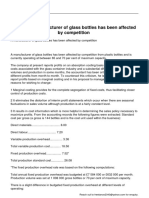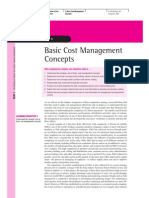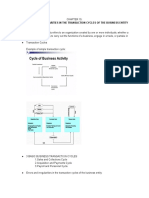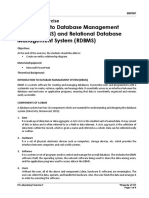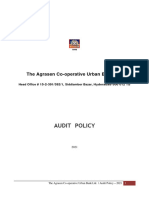AIS 01 - Handout - 1
Uploaded by
Melchie RepospoloAIS 01 - Handout - 1
Uploaded by
Melchie RepospoloBM1908
OVERVIEW OF ACCOUNTING INFORMATION SYSTEM
THE INFORMATION ENVIRONMENT
In Accounting Information System (AIS) environment, information is considered a business resource of an
enterprise. Like the usual resources such as raw materials, labor, and capital, information is vital for the
survival of any business organization in the present era. In day-to-day business operations, vast quantities of
information are given to decision-makers and other users to meet a variety of organizational needs.
According to Hall (2016), information flows out from the organization to external users, such as customers,
suppliers, and stakeholders who have an interest in the firm. Figure 1 presents an overview of these internal
and external information flows.
Figure 1. Internal and External Flows of Information
Source: https: theITeducation.com/wp-content/uploads/2016/01/internal-and-external-flow-of-
information.png?fit=752%2C440&ssl=1
The pyramid shows that the business organization is divided horizontally into several levels of activity.
Business operations form the base of the pyramid. These activities consist of the product-oriented work of
the business organization, such as manufacturing, sales, distribution, billing, and cash receipts. Above the base
level, the organization is divided into three (3) management tiers: operations management, middle
management, and top management.
The following are their functions (Hall, 2016):
• Top Management - It is responsible for longer-term planning and setting organizational objectives.
• Middle Management - It is accountable for the short-term planning and coordination of activities
necessary to accomplish organizational objectives.
• Operations Management - It is is directly responsible for day-to-day operations.
Notice in Figure 1 how information flows in two (2) directions within the organization: horizontally and
vertically.
• Horizontal Flow - It is a flow of information which supports operations-level tasks with highly detailed
facts about many business transactions affecting the firm. This includes information about events such as
the sale and shipment of goods, the use of labor and materials in the production process, and internal
transfers of resources from one (1) department to another (Hall, 2016).
01 Handout 1 *Property of STI
student.feedback@sti.edu Page 1 of 7
BM1908
• Vertical Flow - It is a flow of information which originates from the senior manager down to junior
managers and operations personnel in the form of instructions, quotas, and budgets. In addition,
summarized information pertaining to operations and other activities flows upward to managers at all
levels. Management uses this information to support various planning and control functions (Hall, 2016).
Also, notice in the same figure that there is a curvilinear arrow that points in and out of the pyramid and to
several persons: stakeholders, customers, and suppliers. This represents exchanges between the business and
its external users of information.
External users fall into two (2) groups (Hall, 2016):
• Trading partners - These are persons or organizations with whom the enterprise customarily does
business (e.g. customers, suppliers, etc.). Exchanges with trading partners include customer sales and
billing information, purchase information for suppliers, and inventory receipt information.
• Stakeholders - These are external entities with a direct or indirect interest in the firm. Examples of which
are stockholders, financial institutions, and government agencies. Information exchanges with these
groups include financial statements, tax returns, and stock transaction information.
Information Objectives
Specific information objectives will differ from firm to firm as specific user needs vary. Three (3) fundamental
objectives are, however, common to all organization (Hall, 2016):
1. Support the firm’s day-to-day operations. Operations personnel use information to assist them in the
efficient and effective discharge of their daily tasks.
2. Support management decision making. Managers use information to assist them in planning and
control decisions related to their areas of responsibility.
3. Support the stewardship function of management. Stewardship refers to managers’ responsibility to
properly manage the resources of the firm and report on their activities. External users receive
stewardship information through traditional financial statements and other mandated reports.
Internally, managers receive stewardship information from various responsibility reports.
The Information Systems Framework
The information system is a set of formal procedures by which data are collected, stored, processed into
information, and distributed to users. It is divided into two (2) broad elemental subsystems: the accounting
information systems (AIS) and the management information systems (MIS).
The distinction between AIS and MIS centers on the concept of a transaction, as illustrated below:
Figure 2. Transactions Processed by the Information System
The information system accepts input called transactions, which are converted through various processes into
output information that goes to users. A transaction is an event that affects or is of interest to the organization
01 Handout 1 *Property of STI
student.feedback@sti.edu Page 2 of 7
BM1908
and is processed by its information system as a unit of work. Transactions fall into two (2) classes: financial
transactions and nonfinancial transactions (Hall, 2016).
• Financial transactions - These are economic events measured in monetary terms, which affect the assets
and equities of the organization.
• Nonfinancial transactions - These are events that do not meet the narrow definition of financial
transactions (e.g. adding a new supplier of raw materials to the list of valid suppliers).
The Accounting Information System and Management Information System
• Accounting Information System (AIS) - This system processes financial and nonfinancial transactions that
directly affect the processing of financial transactions. For example, changes to customers’ names and
addresses are processed by AIS to keep the customer file current. Although not technically financial
transactions, these changes provide vital information for processing future sales to the customer.
The three (3) major subsystems of AIS:
o Transaction Processing Systems (TPS) – This supports daily business operations with numerous
reports, documents, and messages for users throughout the organization.
o General Ledger/Financial Reporting System (GL/FRS) - This produces the traditional financial
statements, such as the income statement, balance sheet, statement of cash flows, tax returns, and
other reports required by law.
o Management Reporting System (MRS) - This provides internal management with special-purpose
financial reports and information needed for decision-making such as budgets, variance reports, and
responsibility reports.
• Management Information System (MIS) - This processes nonfinancial transactions that are not normally
processed by traditional AIS. The table below shows an example of typical MIS application related to
functional areas of a firm.
Table 1. Examples of MIS Application in Functional Areas
Source: Accounting Information System, 2016, p. 8
01 Handout 1 *Property of STI
student.feedback@sti.edu Page 3 of 7
BM1908
The General Model for AIS
Figure 3. General Model of Accounting Information System
Source: Accounting Information System, 2016, p. 9
The model depicts the relationship between the key elements that constitute an AIS application: end users,
data sources, data collection, data processing, database management, information generation, and feedback.
• End users – This key element is divided into two (2) general groups (Hall, 2016):
o External users - These include creditors, stockholders, potential investors, regulatory agencies, tax
authorities, suppliers, and customers.
o Internal users - These include management at all levels of the organization, as well as operations
personnel.
• Data sources - This key element is composed of financial transactions that enter the information system
from either internal or external sources.
o External financial transactions - These transactions are considered the most common source of data.
It encompasses economic exchanges with other business entities and individuals outside the firm.
Examples include the sale of goods and services, the purchase of inventory, the receipt of cash, and
the disbursement of cash (Hall, 2016).
o Internal financial transactions - These transactions involve the exchange or movement of resources
within the organization. Examples include the movement of raw materials into work-in-process (WIP),
the application of labor and overhead to WIP, the transfer of WIP into finished goods inventory, and
the depreciation of plant and equipment (Hall, 2016).
• Data collection - This key element is the first operational stage in the information system. Two rules (2)
govern the design of data collection procedures: relevance and efficiency. The information system should
capture only relevant data. The efficient data collection procedures should be designed to collect data
only once. Capturing the same data more than once overloads facilities and leads to data redundancy,
01 Handout 1 *Property of STI
student.feedback@sti.edu Page 4 of 7
BM1908
which causes inconsistencies among the redundant elements and reduces overall system effectiveness
(Hall, 2016).
• Data Processing - This key element comprises tasks (from simple to complex) to produce information.
Examples include mathematical algorithms used for production scheduling applications, statistical
techniques for sales forecasting, and posting and summarizing procedures used for accounting
applications.
• Database Management - This key element refers to a systematic way to create, retrieve, update, and
delete data in a database. The term could apply to a filing cabinet or a computer disk. Regardless of the
database’s physical form, business data are organized in a logical hierarchy. The levels in the data
hierarchy – attribute, record, and file – are illustrated in the following figure (Hall, 2016):
Figure 4. The Data Hierarchy
o Attribute - This is a logical and relevant characteristic of an entity about which the firm captures data.
The attributes shown in Figure 4 are logical because they all relate to a common entity – accounts
receivable (AR). Each attribute is also relevant because it contributes to a common information content
of the entire set of attributes. As proof of this, the absence of any single relevant attribute diminishes
or destroys the information content of the set.
o Record - This is a complete set of attributes for a single occurrence within an entity class. For example,
a particular customer name, address, and account balance is one (1) occurrence (or record) within the
AR class.
o File - This is a complete set of records of an identical class. For example, all the AR records of the
organization constitute the AR file. Similarly, files are constructed for other classes of records such as
inventory, accounts payable, and payroll. The organization’s database is the entire collection of such
files.
• Information Generation - This key element refers to the process of compiling, arranging, formatting, and
presenting information to users. Information can be an operational document such as sales order, a
structured report, or a message on a computer screen. Regardless of physical form, useful information has
the following characteristics: relevance, timeliness, accuracy, completeness, and summarization.
• Feedback - This key element is a form of output that is sent back to the system as a source of data. Feedback
may be internal or external and is used to initiate or alter the process. For example, an inventory status
01 Handout 1 *Property of STI
student.feedback@sti.edu Page 5 of 7
BM1908
report signals the inventory control clerk that items of inventory have fallen to, or below, their minimum
allowable levels.
ORGANIZATIONAL STRUCTURE AND ACCOUNTING INFORMATION SYSTEM
Segmentation by business function is a common method of organizing a business entity. Functional segments
derive from the flow of resources through the firm. For example, assume a manufacturing firm that employs
the following resources: materials, labor, financial capital, and information. The following table shows the
relationship between these resources and the functional segments that manage them (Hall, 2016).
Table 2. Functions from Resources
The segments and the functions vary among the organizations, depending on their size and line of business.
A public water company, for example, does not need to market its product and probably will have little in the
way of advertising or market research functions. The following shows the common functional areas of a
business organization:
Figure 5. Common Functional Areas of a Business Organization
01 Handout 1 *Property of STI
student.feedback@sti.edu Page 6 of 7
BM1908
The functional areas, as shown in Figure 5, are defined as follows (Hall, 2016):
• Materials Management - It is responsible for planning and controlling the materials inventory of the
company. The materials management has three (3) sub-functions:
o Purchasing - It is the task of ordering inventory from vendors when inventory levels fall to their reorder
points.
o Receiving - It is the task of accepting the inventory previously ordered by purchasing.
o Stores - It takes physical custody of the inventory received and releases these resources into the
production process as needed.
• Production - It comprises of activities that occur in the conversion cycle where raw materials, labor, and
plant assets are used to create finished products.
• Marketing - It deals with the strategic problems of product promotion, advertising, and market research.
• Distribution - It is responsible for the activity of getting the product to the customer after sale.
• Personnel - It is responsible for hiring and managing competent and reliable employees, which are a
valuable resource to a business.
• Finance - It manages the financial resources of the firm through banking and treasury activities, portfolio
management, credit evaluation, cash disbursements, and cash receipts.
• Accounting - It plays two (2) important roles in transaction processing. First, it captures and records the
financial effects of the economic events that constitute the firm’s transactions. Second, it distributes
transaction information to operations personnel to coordinate many of their key tasks.
• Information Technology (IT) - It is responsible for data processing, systems development and maintenance,
database administration, and network administration.
THE ROLE OF ACCOUNTANTS IN ACCOUNTING INFORMATION SYSTEM (AIS)
Accountants play two (2) important roles in an accounting information system: either system designers or
system auditors.
• Accountants as System Designers - Accountants act as a domain expert and work hand-in-hand with IT
professionals in systems development and design. As the domain expert, accountants identify the nature
of the required information, the sources, its destination, and the relevant accounting that is applicable in
that specific information.
• Accountants as Systems Auditors - As an auditor, they express opinions regarding the proper presentation
of financial statements. Moreover, the auditor performs tests of the information system’s internal controls
as well as substantive tests of data in the system’s databases.
Reference
Hall, J. A. (2016). Accounting information system. Taguig City: Cengage Learning Asia Pte Ltd.
01 Handout 1 *Property of STI
student.feedback@sti.edu Page 7 of 7
You might also like
- IT312 Systems Integration and Architecture PDF0% (1)IT312 Systems Integration and Architecture PDF55 pages
- A Manufacturer of Glass Bottles Has Been Affected by Competition0% (1)A Manufacturer of Glass Bottles Has Been Affected by Competition2 pages
- Questions: Buy This Full Document at Http://test-Bank - UsNo ratings yetQuestions: Buy This Full Document at Http://test-Bank - Us35 pages
- Nature and Background of The Specialized IndustryNo ratings yetNature and Background of The Specialized Industry3 pages
- System Decomposition: Chapter 1 - The Information System: An Accountant's PerspectiveNo ratings yetSystem Decomposition: Chapter 1 - The Information System: An Accountant's Perspective4 pages
- Chapter 16 - Securities Firms and Investment BanksNo ratings yetChapter 16 - Securities Firms and Investment Banks2 pages
- Errors and Irregularities in The Transaction Cycles of The Business EntityNo ratings yetErrors and Irregularities in The Transaction Cycles of The Business Entity5 pages
- Acc 106 - P1 Examination, Pa 2: Your Email Will Be Recorded When You Submit This FormNo ratings yetAcc 106 - P1 Examination, Pa 2: Your Email Will Be Recorded When You Submit This Form17 pages
- Read Online Here: Financial Accounting and Reporting 1 by MillanNo ratings yetRead Online Here: Financial Accounting and Reporting 1 by Millan5 pages
- Statement of Cash Flows Final Term - 240325 - 221434No ratings yetStatement of Cash Flows Final Term - 240325 - 22143420 pages
- Function and Role of Financial System (Chapter-1)83% (6)Function and Role of Financial System (Chapter-1)44 pages
- An Overview of Transaction Processing (Chapter 2)No ratings yetAn Overview of Transaction Processing (Chapter 2)8 pages
- Intermediate Accounting 2: Bonds PayableNo ratings yetIntermediate Accounting 2: Bonds Payable10 pages
- Post Test Cash and Cash Equivalents Name: Date: Professor: Section: ScoreNo ratings yetPost Test Cash and Cash Equivalents Name: Date: Professor: Section: Score5 pages
- Fundamentals of Accounting and Business Management100% (1)Fundamentals of Accounting and Business Management4 pages
- Specialized Fields and Branches of Accounting100% (2)Specialized Fields and Branches of Accounting2 pages
- 3 Prefinals Exam Intermediate Accounting IA Bloc 3No ratings yet3 Prefinals Exam Intermediate Accounting IA Bloc 33 pages
- Quiz On Gross Profit Method (Theory and Problem)No ratings yetQuiz On Gross Profit Method (Theory and Problem)2 pages
- Discussion 2 Cost Concepts Terminologies and Behaviors 1No ratings yetDiscussion 2 Cost Concepts Terminologies and Behaviors 17 pages
- Information-System-as-an-accountants-Perspective-1No ratings yetInformation-System-as-an-accountants-Perspective-124 pages
- List of Philippine Presidents and Their Contributions100% (1)List of Philippine Presidents and Their Contributions4 pages
- Skills Checklist: Midterm Period: Legend On Level AchievedNo ratings yetSkills Checklist: Midterm Period: Legend On Level Achieved2 pages
- Skills Checklist: Preliminary Period: Legend On Level AchievedNo ratings yetSkills Checklist: Preliminary Period: Legend On Level Achieved2 pages
- Notes Payable Are Obligations Accompanied by A Written Promise To Pay A Certain Amount of Money To TheNo ratings yetNotes Payable Are Obligations Accompanied by A Written Promise To Pay A Certain Amount of Money To The5 pages
- Skills Checklist: Prelim Period: Legend On Level AchievedNo ratings yetSkills Checklist: Prelim Period: Legend On Level Achieved2 pages
- Investment Property and Other Non Current AssetsNo ratings yetInvestment Property and Other Non Current Assets5 pages
- CBMEC 1 BSOA Lesson 1 Introduction To Production and Operations ManagementNo ratings yetCBMEC 1 BSOA Lesson 1 Introduction To Production and Operations Management7 pages
- AI and Its Implications For Market Knowledge in b2b MarketingNo ratings yetAI and Its Implications For Market Knowledge in b2b Marketing10 pages
- Development of A System For Managing and Tracking Warranty Information From Assembled ComputerNo ratings yetDevelopment of A System For Managing and Tracking Warranty Information From Assembled Computer68 pages
- The Teacher and The Community School Culture and Organizational LeadershipNo ratings yetThe Teacher and The Community School Culture and Organizational Leadership10 pages
- Computerised Accounting Systems Ani) FinancicalNo ratings yetComputerised Accounting Systems Ani) Financical57 pages
- MS 207 Management Science Notes Unit 1-4No ratings yetMS 207 Management Science Notes Unit 1-4616 pages
- AMNIT-CU-100-LST-1001-A0 - Precommissioning & Commissioning Plan 1111No ratings yetAMNIT-CU-100-LST-1001-A0 - Precommissioning & Commissioning Plan 111115 pages
- Success Factors in The Implementation of Statistical Process ControlNo ratings yetSuccess Factors in The Implementation of Statistical Process Control23 pages
- Car Rental Management System - System Architecture Document88% (8)Car Rental Management System - System Architecture Document18 pages
- 2 Geography Departmental Handbook New 1No ratings yet2 Geography Departmental Handbook New 1124 pages
- C I M CIM: Omputer Ntegrated AnufacturingNo ratings yetC I M CIM: Omputer Ntegrated Anufacturing21 pages
- Presidents, Advisers, and Foreign Policy The EffectNo ratings yetPresidents, Advisers, and Foreign Policy The Effect23 pages
- A Manufacturer of Glass Bottles Has Been Affected by CompetitionA Manufacturer of Glass Bottles Has Been Affected by Competition
- Questions: Buy This Full Document at Http://test-Bank - UsQuestions: Buy This Full Document at Http://test-Bank - Us
- System Decomposition: Chapter 1 - The Information System: An Accountant's PerspectiveSystem Decomposition: Chapter 1 - The Information System: An Accountant's Perspective
- Chapter 16 - Securities Firms and Investment BanksChapter 16 - Securities Firms and Investment Banks
- Errors and Irregularities in The Transaction Cycles of The Business EntityErrors and Irregularities in The Transaction Cycles of The Business Entity
- Acc 106 - P1 Examination, Pa 2: Your Email Will Be Recorded When You Submit This FormAcc 106 - P1 Examination, Pa 2: Your Email Will Be Recorded When You Submit This Form
- Read Online Here: Financial Accounting and Reporting 1 by MillanRead Online Here: Financial Accounting and Reporting 1 by Millan
- Statement of Cash Flows Final Term - 240325 - 221434Statement of Cash Flows Final Term - 240325 - 221434
- Post Test Cash and Cash Equivalents Name: Date: Professor: Section: ScorePost Test Cash and Cash Equivalents Name: Date: Professor: Section: Score
- Fundamentals of Accounting and Business ManagementFundamentals of Accounting and Business Management
- 3 Prefinals Exam Intermediate Accounting IA Bloc 33 Prefinals Exam Intermediate Accounting IA Bloc 3
- Discussion 2 Cost Concepts Terminologies and Behaviors 1Discussion 2 Cost Concepts Terminologies and Behaviors 1
- Information-System-as-an-accountants-Perspective-1Information-System-as-an-accountants-Perspective-1
- List of Philippine Presidents and Their ContributionsList of Philippine Presidents and Their Contributions
- Skills Checklist: Midterm Period: Legend On Level AchievedSkills Checklist: Midterm Period: Legend On Level Achieved
- Skills Checklist: Preliminary Period: Legend On Level AchievedSkills Checklist: Preliminary Period: Legend On Level Achieved
- Notes Payable Are Obligations Accompanied by A Written Promise To Pay A Certain Amount of Money To TheNotes Payable Are Obligations Accompanied by A Written Promise To Pay A Certain Amount of Money To The
- Skills Checklist: Prelim Period: Legend On Level AchievedSkills Checklist: Prelim Period: Legend On Level Achieved
- CBMEC 1 BSOA Lesson 1 Introduction To Production and Operations ManagementCBMEC 1 BSOA Lesson 1 Introduction To Production and Operations Management
- AI and Its Implications For Market Knowledge in b2b MarketingAI and Its Implications For Market Knowledge in b2b Marketing
- Development of A System For Managing and Tracking Warranty Information From Assembled ComputerDevelopment of A System For Managing and Tracking Warranty Information From Assembled Computer
- The Teacher and The Community School Culture and Organizational LeadershipThe Teacher and The Community School Culture and Organizational Leadership
- AMNIT-CU-100-LST-1001-A0 - Precommissioning & Commissioning Plan 1111AMNIT-CU-100-LST-1001-A0 - Precommissioning & Commissioning Plan 1111
- Success Factors in The Implementation of Statistical Process ControlSuccess Factors in The Implementation of Statistical Process Control
- Car Rental Management System - System Architecture DocumentCar Rental Management System - System Architecture Document
- Presidents, Advisers, and Foreign Policy The EffectPresidents, Advisers, and Foreign Policy The Effect

